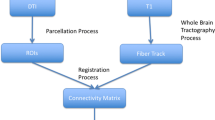Abstract
There has been special interest lately in using graph theory to study brain networks, as it provides the theoretic and visualization means to study the ”disconnection syndrome” for schizophrenia. In this work we try to visualize the graphs derived from electroencephalografic (EEG) signals using several graph drawing techniques and incorporate them smoothly into an easy-to-use framework. The aim is to reveal and evaluate important properties of brain networks.
Preview
Unable to display preview. Download preview PDF.
Similar content being viewed by others
References
Lee, K.H., Williams, L.M., Breakspear, M., Gordon, E.: Synchronous gamma activity: a review and contribution to an integrative neuroscience model of schizophrenia. Brain Res. Brain Res. Rev. 41, 57–78 (2003)
Andreasen, N.C., Paradiso, S., O’Leary, D.S.: Cognitive dysmetria as an integrative theory of schizophrenia: a dysfunction in corticalsubcortical- cerebellar circuitry? Schizophr Bull 24, 203–218 (1998)
Conklin, H.M., Curtis, C.E., Calkins, M.E., Iacomo, W.G.: Working memory functioning in schizophrenia patients and their first-degree relatives: cognitive functioning shedding light on aetiology. Neuropsychologia 43, 930–942 (2005)
Silver, H., Feldman, P., Bilker, W., Gur, R.C.: Working memory deficit as a core neuropsychological dysfunction in schizophrenia. Am. J. Psychiatry 160, 1809–1816 (2003)
Varela, F., Lachaux, J.P., Rodriguez, E., Martinerie, J.: The brainweb: phase synchronization and large-scale integration. Nat. Rev. Neurosci. 2, 229–239 (2001)
Fingelkurts, A.A., Kähkönen, S.: Functional connectivity in the brain–is it an elusive concept? Neurosci. Biobehav. Reviews 28, 827–836 (2004)
Jasper, H.H.: The 10-20 electrode system of the International Federation in Electroencephalography and Clinical Neurophysiology. EEG Journal 10, 370–375 (1958)
Sakkalis, V., Oikonomou, T., Pachou, E., Tollis, I.G., Micheloyannis, S., Zervakis, M.: Time-significant Wavelet Coherence for the Evaluation of Schizophrenic Brain Activity using a Graph theory approach, IEEE-EMBS, New York City, USA (accepted for publication, 2006)
Fruchterman, T., Reingold, E.: Graph Drawing by Force-Directed Placement. Softw. Pract. Exp. 21(11), 1129–1164 (1991)
Kamada, T., Kawai, S.: An Algorithm for Drawing General Undirected Graphs. Inform. Process. Lett. 31, 7–15 (1989)
Kamada, T.: Visualizing Abstract Objects and Relations. World Scientific Series in Computer Science (1989)
Eades, P.: A Heuristic for Graph Drawing. Congr. Numer. 42, 149–160 (1984)
Garey, M., Johnson, D.: Computers and Intractability: A Guide to the Theory of NP-Completeness. Freeman, New York (1979)
Masuda, S., Kashiwabara, T., Nakajima, K., Fujisawa, T.: On the NP-Completeness of a Computer Network Layout Problem. In: Proc. IEEE 1987 International Symposium on Circuits and Systems, Philadelphia, PA, pp. 292–295 (1987)
Six, J.M (Urquhart).: Vistool: A Tool For Visualizing Graphs, Ph.D. Thesis, The University of Texas at Dallas (2000)
Six, J.M., Tollis, I.G.: Circular Drawings of Biconnected Graphs. In: Goodrich, M.T., McGeoch, C.C. (eds.) ALENEX 1999. LNCS, vol. 1619, pp. 57–73. Springer, Heidelberg (1999)
Six, J.M., Tollis, I.G.: Circular Drawings of Telecommunication Networks. In: Fotiadis, D.I., Nikolopoulos, S.D. (eds.) Advances in Informatics, Selected Papers from HCI 1999, pp. 313–323. World Scientific, Singapore (2000)
Watts, D.J., Strogatz, S.H.: Collective dynamics of ’small-world’ networks. Nature 393, 440–442 (1998)
Author information
Authors and Affiliations
Editor information
Editors and Affiliations
Rights and permissions
Copyright information
© 2006 Springer-Verlag Berlin Heidelberg
About this paper
Cite this paper
Oikonomou, T., Sakkalis, V., Tollis, I.G., Micheloyannis, S. (2006). Searching and Visualizing Brain Networks in Schizophrenia. In: Maglaveras, N., Chouvarda, I., Koutkias, V., Brause, R. (eds) Biological and Medical Data Analysis. ISBMDA 2006. Lecture Notes in Computer Science(), vol 4345. Springer, Berlin, Heidelberg. https://doi.org/10.1007/11946465_16
Download citation
DOI: https://doi.org/10.1007/11946465_16
Publisher Name: Springer, Berlin, Heidelberg
Print ISBN: 978-3-540-68063-5
Online ISBN: 978-3-540-68065-9
eBook Packages: Computer ScienceComputer Science (R0)




